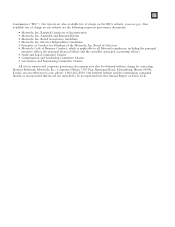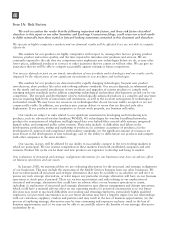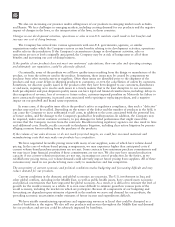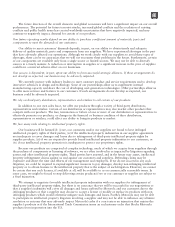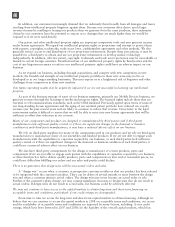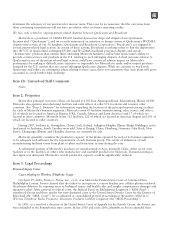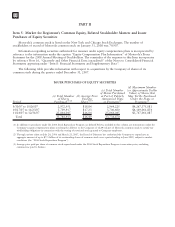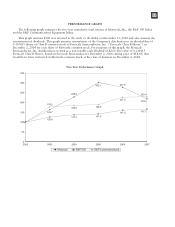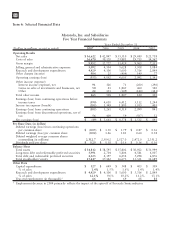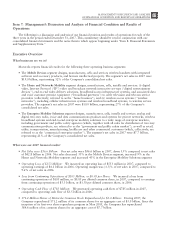Motorola 2007 Annual Report Download - page 35
Download and view the complete annual report
Please find page 35 of the 2007 Motorola annual report below. You can navigate through the pages in the report by either clicking on the pages listed below, or by using the keyword search tool below to find specific information within the annual report.
determine the adequacy of our provision for income taxes. There can be no assurance that the outcomes from
these continuing examinations will not have an adverse effect on future operating results.
We face risks related to ongoing patent-related disputes between Qualcomm and Broadcom.
Motorola is a purchaser of CDMA EV-DO baseband processor chips and chipsets from Qualcomm
Incorporated (“Qualcomm”), and we recently announced an intention to design certain of Qualcomm’s W-CDMA
chipsets into certain of our 3G handsets. Qualcomm and Broadcom Corporation (“Broadcom”) are engaged in
several patent-related legal actions. In certain of these actions, Broadcom is seeking orders to ban the importation
into the U.S. of Qualcomm’s infringing EV-DO and W-CDMA baseband processor chipsets and certain
“downstream” products that contain them (including Motorola handsets) and/or limit Qualcomm’s ability to
provide certain services and products in the U.S. relating to such infringing chipsets. A final outcome adverse to
Qualcomm in any of the patent-related legal actions could have a material adverse impact on Motorola’s
performance by making it difficult, more expensive or impossible for Motorola to make and/or import products
destined for the U.S. market that use certain infringing Qualcomm chipsets. While we continue to work with
Qualcomm and others on contingency plans relating to these cases, there is no guarantee that such plans will prove
successful or avoid further legal challenge.
Item 1B: Unresolved Staff Comments
None.
Item 2: Properties
Motorola’s principal executive offices are located at 1303 East Algonquin Road, Schaumburg, Illinois 60196.
Motorola also operates manufacturing facilities and sales offices in other U.S. locations and in many other
countries. (See “Item 1: Business” for information regarding the location of the principal manufacturing facilities
for each of Motorola’s business segments.) Motorola owns 43 facilities (manufacturing, sales, service and office),
26 of which are located in Americas Region (USA, Canada, Mexico and Latin America) and 17 of which are
located in other countries. Motorola leases 313 facilities, 122 of which are located in Americas Region and 191 of
which are located in other countries.
During 2007, facilities in: Guangzhou, China; Cork, Ireland; Arlington Heights, Illinois (Ridge Buildings); and a
land parcel in Anderson, South Carolina were sold. Sites at Beijing, China; Flensburg, Germany; Glen Rock, New
Jersey; Champaign, Illinois; and Chandler, Arizona, are currently for sale.
Motorola generally considers the productive capacity of the plants operated by each of its business segments
to be adequate and sufficient for the requirements of each business group. The extent of utilization of such
manufacturing facilities varies from plant to plant and from time to time during the year.
A substantial portion of Motorola’s products are manufactured in Asia, primarily China, either in our own
facilities or in the facilities of others who manufacture and assemble products for Motorola. If manufacturing in
the region was disrupted, Motorola’s overall productive capacity could be significantly reduced.
Item 3: Legal Proceedings
Personal Injury Cases
Cases relating to Wireless Telephone Usage
On April 19, 2001, Farina v. Nokia, Inc., et al., was filed in the Pennsylvania Court of Common Pleas,
Philadelphia County. Farina claimed that the failure to incorporate a remote headset into cellular phones rendered
the phones defective by exposing users to biological injury and health risks and sought compensatory damages and
injunctive relief. After removal to federal court, the Judicial Panel on Multidistrict Litigation (“MDL Panel”)
transferred Farina and three similar but now dismissed cases to the United States District Court for the District of
Maryland (the “MDL Court”) for coordinated or consolidated pretrial proceedings in the matter called In re
Wireless Telephone Radio Frequency Emissions Products Liability Litigation (the “MDL Proceeding”).
In 2005, as a result of a decision of the United States Court of Appeals for the Fourth Circuit, the Farina case
was remanded to the Pennsylvania state courts. In late 2005 and early 2006, plaintiffs in Farina amended their
27


